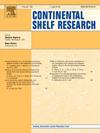地中海:关于表层沉积物的空间分布及其起源、海底起伏和水循环格局的概述
IF 2.2
3区 地球科学
Q2 OCEANOGRAPHY
引用次数: 0
摘要
考虑到不同的无机和有机物质来源、海底起伏和水循环模式,本文对地中海浅层松散海底沉积物中陆源与生物源碳酸盐物质的来源和空间分布进行了结论性的描述。陆源物质占地中海海底大约四分之三的面积,主要在地中海中部和地中海西部和东部的北部。这种优势归因于大量的河流输入和地中海水域普遍的少营养性质。相反,富含生物源碳酸盐的沉积物在地中海中部和东部的南部地区更为普遍,尽管那里的营养条件少,但生物源碳酸盐的存在是由最小的陆地贡献维持的,主要来自撒哈拉沙尘沉积。地表水循环虽然不如陆架水域的河流通量和初级生产重要,但在陆架断裂以外的沉积过程中起着重要作用,并对局部开阔海沉积物分布格局负责。最后,讨论了与陆源和生物源沉积物的产生、转移和沉积有关的人为干预和持续气候变化的表达。本文章由计算机程序翻译,如有差异,请以英文原文为准。
Mediterranean Sea: An overview of the spatial distribution of surficial sediment in relation to their origin, seabed relief and water circulation patterns
The present paper provides a conclusive picture of the origin and spatial distribution of terrigenous versus biogenic carbonate material in the surficial unconsolidated seafloor sediments of the Mediterranean Sea, considering the different sources of inorganic and organic material, the seafloor relief and water circulation patterns. Terrigenous material dominates about three quarters of the Mediterranean seafloor, mainly in the central Mediterranean and the northern parts of the western and eastern Mediterranean. This dominance is attributed to significant riverine inputs and the generally oligotrophic nature of Mediterranean waters. Conversely, biogenic carbonate-rich sediments are more prevalent in the southern parts of the central and eastern Mediterranean where, despite the oligotrophic conditions, the presence of biogenic carbonate is maintained by minimal terrestrial contributions, mainly from Saharan dust deposition. Surface water circulation, although less important than riverine fluxes and primary production in shelf waters, plays an important role in sedimentation processes beyond the shelf break and is responsible for localized open sea sediment distribution patterns. Finally, anthropogenic interventions and expressions of ongoing climate change are discussed in relation to the production, transfer and deposition of both terrigenous and biogenic sediments.
求助全文
通过发布文献求助,成功后即可免费获取论文全文。
去求助
来源期刊

Continental Shelf Research
地学-海洋学
CiteScore
4.30
自引率
4.30%
发文量
136
审稿时长
6.1 months
期刊介绍:
Continental Shelf Research publishes articles dealing with the biological, chemical, geological and physical oceanography of the shallow marine environment, from coastal and estuarine waters out to the shelf break. The continental shelf is a critical environment within the land-ocean continuum, and many processes, functions and problems in the continental shelf are driven by terrestrial inputs transported through the rivers and estuaries to the coastal and continental shelf areas. Manuscripts that deal with these topics must make a clear link to the continental shelf. Examples of research areas include:
Physical sedimentology and geomorphology
Geochemistry of the coastal ocean (inorganic and organic)
Marine environment and anthropogenic effects
Interaction of physical dynamics with natural and manmade shoreline features
Benthic, phytoplankton and zooplankton ecology
Coastal water and sediment quality, and ecosystem health
Benthic-pelagic coupling (physical and biogeochemical)
Interactions between physical dynamics (waves, currents, mixing, etc.) and biogeochemical cycles
Estuarine, coastal and shelf sea modelling and process studies.
 求助内容:
求助内容: 应助结果提醒方式:
应助结果提醒方式:


